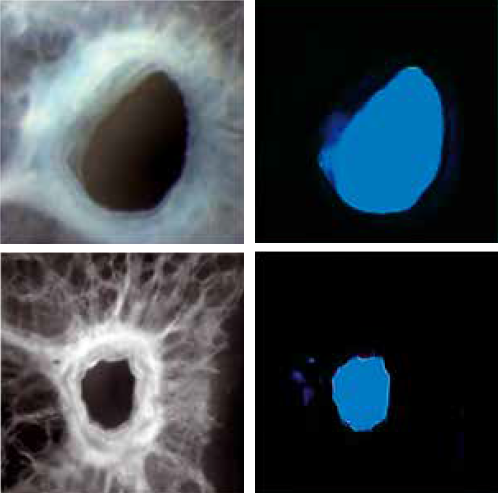The availability of large amounts of data has revolutionized research in the life sciences in the past few years, offering a wide range of opportunities for knowledge gain and future applications. By combining the disciplines of mathematics, computer science, medicine and life sciences, bioinformatics has made it possible to store, categorize, analyze, evaluate and visualize biological data and to simulate biochemical processes.
Applied bioinformatics and artificial intelligence
Getting the most out of big data for biomedical translation
Application areas at Fraunhofer ITEM

At Fraunhofer ITEM, researchers develop methods and possibilities for the preparation, analysis and visualization of biomedical data, as well as data models and data analysis pipelines. The focus of our research is on the mapping of cellular and regulatory processes and their translation into applications for humans. Bioinformatics methods are used, for example, for personalized tumor therapy to develop optimized testing strategies and for research on RNAs as diagnostic biomarkers and therapeutic targets. For personalized therapies or for patient stratification, the knowledge gained from big data is key to identifying adequate treatment strategies. Stratification also plays a major role for hazard and risk assessment of chemicals, nanomaterials, and environmental exposure, as the sensitivity to noxious agents differs between subpopulations.
In addition, the Fraunhofer researchers are using bioinformatics and artificial intelligence to advance towards intelligent image data analysis and are further developing this technology, so as to optimize the analysis of histological images and support clinical processes.
You may also be interested in these topics:
Publications
- Cao, S., Li, Y., Song, R., Meng, X., Fuchs, M., Liang, C., Kachler, K., Meng, X., Wen, J., Schlotzer-Schrehardt, U., Taudte, V., Gessner, A., Kunz, M., Schleicher, U., Zaiss, M. M., Kastbom, A., Chen, X., Schett, G., Bozec, A. (2024). L-arginine metabolism inhibits arthritis and inflammatory bone loss. Annals of the Rheumatic Diseases 83(1): 72-87. doi: 10.1136/ard-2022-223626 https://ard.bmj.com/content/early/2023/10/25/ard-2022-223626.long - Open Access
- Das, P. P., Marcel Mast, Wiese, L., Jack, T., Wulff, A., ELISE STUDY GROUP (2023). Data Extraction for Associative Classification using Mined Rules in Pediatric Intensive Care Data. In: BTW 2023. Lecture Notes in Informatics (LNI), Gesellschaft für Informatik. König-Ries, B., Scherzinger, S., Lehner, W. & Vossen, G https://dl.gi.de/handle/20.500.12116/40376
- Ghaffari, M. H., Daniel, J. B., Sadri, H., Schuchardt, S., Martín-Tereso, J., Sauerwein, H. (2024). Longitudinal characterization of the metabolome of dairy cows transitioning from one lactation to the next one: Investigations in blood serum. Journal of Dairy Science 107(2): 1263-1285. doi: 10.3168/jds.2023-23841 https://www.sciencedirect.com/science/article/pii/S0022030223007075?via%3Dihub - Open Access
- Hoda, U., Pavlidis, S., Bansal, A. T., Takahashi, K., Hu, S., Ng Kee Kwong, F., Rossios, C., Sun, K., Bhavsar, P., Loza, M., Baribaud, F., Chanez, P., Fowler, S. J., Horvath, I., Montuschi, P., Singer, F., Musial, J., Dahlen, B., Krug, N., Sandstrom, T., Shaw, D. E., Lutter, R., Fleming, L. J., Howarth, P. H., Caruso, M., Sousa, A. R., Corfield, J., Auffray, C., De Meulder, B., Lefaudeux, D., Dahlen, S. E., Djukanovic, R., Sterk, P. J., Guo, Y., Adcock, I. M., Chung, K. F., group, U. B. s. (2022). Clinical and transcriptomic features of persistent exacerbation-prone severe asthma in U-BIOPRED cohort. Clin Transl Med 12(4): e816. doi: 10.1002/ctm2.816 https://onlinelibrary.wiley.com/doi/10.1002/ctm2.816 - Open Access
- Junger, H., Muhlbauer, M., Brennfleck, F. W., Schurr, L. A., Goetz, M., Eggenhofer, E., Kirchner, G., Evert, K., Fichtner-Feigl, S., Geissler, E. K., Schlitt, H. J., Brunner, S. M. (2023). Early gammaGT and bilirubin levels as biomarkers for regeneration and outcomes in damaged bile ducts after liver transplantation. Clinical Transplantation: e14880, doi: 10.1111/ctr.14880 https://onlinelibrary.wiley.com/doi/10.1111/ctr.14880 - Open Access
- Kaltdorf, M., Breitenbach, T., Karl, S., Fuchs, M., Kessie, D. K., Psota, E., Prelog, M., Sarukhanyan, E., Ebert, R., Jakob, F., Dandekar, G., Naseem, M., Liang, C., Dandekar, T. (2023). Software JimenaE allows efficient dynamic simulations of Boolean networks, centrality and system state analysis. Scientific Reports 13(1): 1855. doi: 10.1038/s41598-022-27098-7 https://www.nature.com/articles/s41598-022-27098-7 - Open Access
- Lietz, K., Saremi, B., Wiese, L. (2023). Genealyzer: web application for the analysis and comparison of gene expression data. BMC Bioinformatics 24(1): 150. doi: 10.1186/s12859-023-05266-4 https://bmcbioinformatics.biomedcentral.com/articles/10.1186/s12859-023-05266-4 - Open Access
- Nguyen, M. H., Onken, A., Wulff, A., Foremny, K., Torgau, P., Schutte, H., Hild, S., Doll, T. (2023). Computational Modeling of Diffusion-Based Delamination for Active Implantable Medical Devices. Bioengineering (Basel) 10(5). doi: 10.3390/bioengineering10050625 https://www.mdpi.com/2306-5354/10/5/625 - Open Access
- Sanz, F., Pognan, F., Steger-Hartmann, T., Díaz, C., Asakura, S., Amberg, A., Bécourt-Lhote, N., Blomberg, N., Bosc, N., Briggs, K., Bringezu, F., Brulle-Wohlhueter, C., Brunak, S., Bueters, R., Callegaro, G., Capella-Gutierrez, S., Centeno, E., Corvi, J., Cronin, M. T. D., Drew, P., Duchateau-Nguyen, G., Ecker, G. F., Escher, S., Felix, E., Ferreiro, M., Frericks, M., Furlong, L. I., Geiger, R., George, C., Grandits, M., Ivanov-Draganov, D., Kilgour-Christie, J., Kiziloren, T., Kors, J. A., Koyama, N., Kreuchwig, A., Leach, A. R., Mayer, M.-A., Monecke, P., Muster, W., Nakazawa, C. M., Nicholson, G., Parry, R., Pastor, M., Piñero, J., Oberhauser, N., Ramírez-Anguita, J. M., Rodrigo, A., Smajic, A., Schaefer, M., Schieferdecker, S., Soininen, I., Terricabras, E., Trairatphisan, P., Turner, S. C., Valencia, A., van de Water, B., van der Lei, J. L., van Mulligen, E. M., Vock, E., Wilkinson, D. (2023). eTRANSAFE: data science to empower translational safety assessment. Nature Reviews Drug Discovery 22(8): 605-606. doi: 10.1038/d41573-023-00099-5 https://www.nature.com/articles/d41573-023-00099-5
- Schlieter, H., Kahlig, M., Hickmann, E., Furstenau, D., Sunyaev, A., Richter, P., Breitschwerdt, R., Thielscher, C., Gersch, M., Maass, W., Reuter-Oppermann, M., Wiese, L. (2024). [Digital health applications (DiGA) in the area of tension between progress and criticism : Discussion paper from the "Digital health" specialist group of the German Informatics Society]. Bundesgesundheitsblatt Gesundheitsforschung Gesundheitsschutz 67(1): 107-114. doi: 10.1007/s00103-023-03804-2 https://link.springer.com/article/10.1007/s00103-023-03804-2 - Open Access
- Tappermann, C., Xu, M., Wiese, L., Saremi, B. (2024). Development of an End-to-End Web Application for Visualization, Evaluation, and Post-processing of Result Data from Neural Network Predictions for the Melanoma Use Case. In: Casteleyn, S., Mikkonen, T., García Simón, A., Ko, IY., Loseto, G. (eds) Current Trends in Web Engineering. ICWE 2023. Communications in Computer and Information Science, vol. 1898. Springer, Cham. https://link.springer.com/chapter/10.1007/978-3-031-50385-6_11
- Vrijenhoek, N. G., Wehr, M. M., Kunnen, S. J., Wijaya, L. S., Callegaro, G., Mone, M. J., Escher, S. E., Van de Water, B. (2022). Application of high-throughput transcriptomics for mechanism-based biological read-across of short-chain carboxylic acid analogues of valproic acid. Altex [Epub ahead of print]. doi: 10.14573/altex.2107261 https://www.altex.org/index.php/altex/article/view/2334 - Open Access
 Fraunhofer Institute for Toxicology and Experimental Medicine
Fraunhofer Institute for Toxicology and Experimental Medicine